Gibson Les Paul
| Gibson Les Paul | |
|---|---|
|
1958 Gibson Les Paul Standard | |
| Manufacturer | Gibson |
| Period |
1952–1960 1961–1963 (in SG form) 1968–present |
| Construction | |
| Body type | Solid, Hollow, Semi-hollow |
| Neck joint | Set neck |
| Woods | |
| Body |
Mahogany (often with a maple top) Swamp ash (rare) |
| Neck |
Usually mahogany Maple |
| Fretboard |
Usually Rosewood Ebony Maple Richlite |
| Hardware | |
| Bridge | Usually Tune-O-Matic |
| Pickup(s) |
Usually 2 humbuckers 2 P-90s 3 humbuckers |
| Colors available | |
|
Various, often sunburst-type finishes Goldtop Ebony Alpine White Wine Red | |
The Gibson Les Paul is a solid body electric guitar that was first sold by the Gibson Guitar Corporation in 1952.[1] The Les Paul was designed by Gibson president Ted McCarty, factory manager John Huis and their team, along with guitarist/inventor Les Paul.
The Les Paul was originally offered with a gold finish and two P-90 pickups. In 1957, humbucking pickups were added, along with sunburst finishes in 1958. The sunburst 1958–1960 Les Paul – today one of the best-known electric guitar types in the world – was considered a failure, with low production and sales. For 1961, the Les Paul was redesigned into what is now known as the Gibson SG. This design continued until 1963 but continued as a separate guitar, when the traditional single cutaway, carved top bodystyle was re-introduced. The Les Paul has been continually produced in countless versions and editions since. Along with Fender's Telecaster and Stratocaster, it was one of the first mass-produced electric solid-body guitars. Les Pauls have been used in many genres, including rock, country, pop, soul, rhythm and blues, blues, jazz, reggae, punk, and heavy metal.
History
| Prototypes on Rock and Roll Hall of Fame and Les Paul House of Sound (2009) | |
|
| |
|
| |
|
based on 1942 Epiphone Broadway[3][4] | |
|
| |
|
|
Origins (1950–1952)
.jpg)
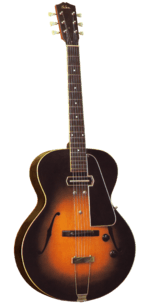
In 1950, the ancestors of Fender Telecaster (Fender Esquire and Fender Broadcaster) were introduced to the musical market and solid-body electric guitars became a public craze. In reaction to market demand, Gibson Guitar president Ted McCarty brought guitarist Les Paul into the company as a consultant. Les Paul was a respected innovator who had been experimenting with guitar design for years. He hand-built a solid-body prototype called "The Log", often suggested as the first solid-body Spanish guitar ever built. "The Log" was given its name from the pine block running through the middle of the guitar whose width and depth are a little more than the width of the fretboard; conventional hollow guitar sides or "wings" were added for shape. Although numerous other prototypes and limited-production solid-body models by other makers have since surfaced, it is known that in 1945–1946, Les Paul had approached Gibson with "The Log" prototype, but his solid body design was rejected.[7][8]
In 1951, Paul, McCarty, and his team at the Gibson Guitar Corporation began work on what would eventually become the Les Paul Model. Early prototypes are very similar to the final version.[9] The new Les Paul guitar was to be an expensive, well-made instrument in accordance with Gibson's reputation at the time.[7] Although recollections differ regarding who contributed what to the Les Paul design, it was far from a replica of rival guitar manufacturer Fender's models.
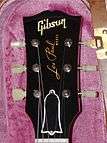
Additionally, Gibson's president Ted McCarty stated that the Gibson Guitar Corporation approached Les Paul for the right to imprint the musician's name on the headstock with the intention of increasing sales; in 1951, Gibson presented Paul a nearly finished instrument for approval. Subsequently, McCarty claimed that design discussions with Les Paul were limited to the tailpiece and the fitting of a maple cap over the mahogany body for increased density and sustain, which Les Paul had requested reversed. However, this reversal would have caused the guitar to become too heavy, and Paul's request was refused.[10] Paul states that the original Custom should have had the maple cap and the Goldtop was to be all mahogany. The Custom did not appear on the market for another two years following the introduction of the Goldtop; it is possible that Gibson had planned a full model range of guitars (with a roll-out over the course of several years) at the time when initial specifications were being set. Les Paul's contributions to the guitar line bearing his name were more than cosmetic, but certainly included them. For example, Paul specified that the guitar be offered in a gold finish, not only for flashiness, but to emphasize the high quality of the Gibson Les Paul instrument.[10] The later-issue Les Paul models included flame maple (tiger stripe) and "quilted" maple tops, again in contrast to the competing Fender line's range of car-like custom color finishes.
The 1952 Les Pauls featured two P-90 single coil pickups, and a one-piece, 'trapeze'-style bridge/tailpiece with strings fitted under (instead of over) a steel stop-bar.[note 4]
Mid-1950s (1953–1957)

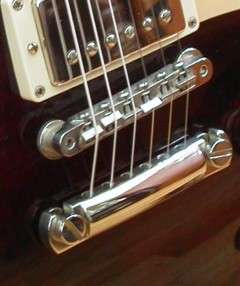
A second Les Paul model was introduced in 1953. Called the Les Paul Custom, this black guitar with gold-plated hardware was dubbed the "Black Beauty". Various bridge and tailpiece designs were added in 1953 and 1954, including the popular Tune-o-matic bridge. The Goldtop and Custom models continued without significant changes until 1957. In 1957, P-90 pickups were no longer offered on Les Pauls. New humbucker pickups designed by Seth Lover in 1955 (U.S. Patent 2,896,491) debuted on Les Pauls in 1957. This innovation in pickups became the flagship pickup design most associated with Gibson. Many other guitar companies followed suit, outfitting their electrics with versions of the humbucking pickup.
Sunburst failure and resurgence (1958–1968)
_edited.jpg)
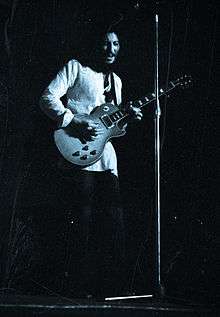
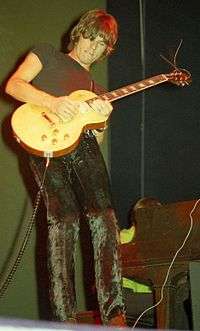
In 1958, the Les Paul saw its first major design change. A new model, called the Standard, retained most features of the 1957 Goldtop. However, Standards featured a cherry-red sunburst finish. These guitars were priced higher than the Goldtop models, but lower than the Customs. At this time, Gibson instruments were marketed toward an older, jazz-oriented audience rather than young burgeoning guitarists. As a result, over the three-year period of production, only c. 1,700 Standards were made.
These Les Pauls were considered to be too heavy and old-fashioned, and they initially did not find favor amongst guitarists. In 1961, Gibson stopped producing the traditional Les Paul in favor of a lighter redesign which was later called the SG. The mid-1960s, however, brought a resurgence of interest in the Les Paul Standard. In 1964, The Rolling Stones' Keith Richards began using a sunburst, 1959 Les Paul Standard – becoming the first "star-guitarist" to play a Les Paul on the British scene.[11][12] The guitar, outfitted with a Bigsby tailpiece, served as one of the guitarist's prominent instruments and provided the first impetus to the use of Les Pauls during the British blues boom.[13][14] In 1965, Eric Clapton began using Les Pauls because of the influence of Freddie King and Hubert Sumlin, and played a 1960 Standard on the groundbreaking album Blues Breakers with Eric Clapton.[15][16][17] In America, Mike Bloomfield began using a 1954 Les Paul goldtop while touring with the Paul Butterfield Blues Band, and recorded most of his work on the band's East-West album with that guitar. A year later, he traded it for a 1959 Standard with which he became most identified. By 1967, Jerry Garcia of the Grateful Dead was using mid-1950's, P-90 pickup-equipped goldtops or black custom models, which he used through 1968.[18] Concurrently, artists such as Peter Green, Jeff Beck, Paul Kossoff, and Jimmy Page began using sunburst Les Paul Standards in the late 1960s. Responding to this influence and increased pressure from the public, Gibson reintroduced Les' single-cutaway guitar in July 1968, and the guitar remains in production today.
ECL and Norlin-era (1969–85)
In 1969, Gibson's parent company (Chicago Musical Instruments) was taken over by the conglomerate ECL.[19][20] Gibson remained under the control of CMI until 1974 when it became a subsidiary of Norlin Musical Instruments.
_pancake_body_side_(2010-02-28_by_TT_Zop).jpg)
These ownership changes, often called the "Norlin Era", caused Gibson products of the time to decline in quality. Les Paul designs were altered and a reinforced upper neck volute to decrease headstock breaks was added. Neck woods were changed from one-piece mahogany to a three-piece maple design. The body was also changed from one-piece mahogany with a maple top to multiple slabs of mahogany with multiple pieced maple tops. This is referred to as "multipiece" construction, and sometimes incorrectly referred to as a "pancake" body. The expression "pancake body" actually refers to a body made of a thin layer of maple sandwiched between two slabs of mahogany, with a maple cap. The grain of the maple was placed at 90 degrees to that of the mahogany. The "pancake"-like layers are clearly visible when looking at the edge of the guitar. This process is also known as "crossbanding", and was done to make use of less expensive and more readily available thinner mahogany. Crossbanding was phased out by 1977.
In this era, Gibson began experimenting with new models, such as the Les Paul Recording. This guitar was generally unpopular with guitarists because of its complex electronics. Less noticeable changes included, but were not limited to, optional maple fingerboards (added in 1976), pickup cavity shielding, and the crossover of the ABR1 Tune-o-matic bridge into the wide "Nashville" bridge. During the 1970s, the Les Paul body shape was incorporated into other Gibson models, including the S-1, the Sonex, the L6-S, and other models that did not follow the classic Les Paul layout.
Modern Les Pauls (1986–present)

In January 1986, Gibson again changed ownership and began manufacturing a range of varied Les Paul models. The 1980s also saw the end to several design characteristics, including the volute and maple neck. However, because of consumer demand, the Gibson Les Paul guitar is available today in a wide array of choices, ranging from guitars equipped with modern digital electronics to classic re-issue models built to match the look and specifications of the guitar's earliest production runs from 1952 to 1960.
In 1986, to respond to the high demand for vintage models, Gibson formed a "Custom Shop" division. Originally, the Shop began producing accurate reproductions of early Les Pauls as well as one-off orders.[21] Today, the Custom Shop produces numerous limited-run "historic-spec" models, as well as signature artist models. The first Custom Shop artist guitar was the 1996 Joe Perry Les Paul.
Models and variations
The post-1954 Les Paul guitar line included two models: the Standard (nicknamed the Goldtop), and the Custom (which offered gold hardware and a more formal black finish). However, advancements in pickup, body, and hardware designs allowed the Les Paul to become a long-term series of electric solid-body guitars that targeted multiple price-points and market levels.
Goldtop (1952–present)


.jpg)
.png)
Goldtops, the first Les Paul model, were produced from 1952–1957. Early 1952 Les Pauls were not issued serial numbers, did not have bound fingerboards, and are considered by some as "LP Model prototypes". However, later 1952 Les Pauls were issued serial numbers and also came with bound fingerboards. Interestingly, the design scheme of some of these early models varied. For instance, some early Les Pauls were fitted with black covered P90 pickups instead of the cream-colored plastic covers that are associated with this guitar. The weight and the tonal characteristics of the Goldtop Les Paul were largely due to the mahogany and maple construction.
In 1953, the trapeze tailpiece was dropped, and a new stopbar design was added. This design combined a pre-intonated bridge and tailpiece with two studs just behind the bridge pickup. This increased the sustain of the Goldtop noticeably; however, the intonation and string height adjustability were limited. A new design, the Tune-o-matic, replaced the stopbar in 1955. It consisted of a separate bridge and tailpiece attached directly to the top of the guitar, combining an easily adjustable bridge with a sustain-carrying tailpiece. This design has been used on most Les Pauls ever since. The tuners were produced by Kluson.
Custom (1954–60, 1968–present)

.jpg)
The Les Paul Custom features gold hardware, multilayer binding including the headstock, ebony fingerboard, real mother-of-pearl inlays and two or three-pickup layout. 1950s Customs were all-mahogany, rather than the mahogany-with-maple-cap of the Goldtop. The original Customs were fitted with a P-90 pickup in the bridge position and an Alnico V "staple" pickup in the neck. In 1957, the Custom was fitted with Gibson's new PAF humbucker pickups,[22] and later became available with three pickups instead of the usual two. The traditional Les Paul Custom was discontinued in 1961 and its name transferred to the custom version of the then-new Gibson SG.
In 1968, Gibson reintroduced the Les Paul Custom as a two-pickup-only model. The headstock angle was changed from 17 degrees to 14, and a wider headstock and a maple top (in lieu of the original 1953-1961 mahogany top construction) were added. White and two sunburst finish options were added to the color palette in 1974. Also new in 1974 was the optional TP-6 fine-tuner tailpiece, allowing for micro-adjustment of string tuning from the bridge. The mahogany neck was replaced with a three-piece maple neck in 1975 (though mahogany still saw limited use) with this change lasting till around 1982. Popular colors, such as wine red and "silverburst," were added in the 1970s and '80s. Gibson currently produces several Custom models with various finishes and pickups.
Junior (1954–60, 2015–present) and TV (1955–60)
.png)
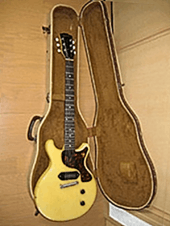
(Junior DC in TV Yellow)
In 1954, the Les Paul Junior debuted, targeted the beginning or student guitarist. The Junior is characterized by its flat-top "slab" mahogany body, finished in sunburst. It had a single P-90 pickup, simple volume and tone controls, an unbound rosewood fingerboard with plain dot-shape position markers, and a combination bridge/tailpiece unit similar to the Goldtop.
In 1955, Gibson launched the Les Paul TV model, which was essentially a Junior with what Gibson called a natural finish. This finish was more of a translucent mustard yellow through which the wood grain could be seen, and was not unlike the finish that competitor Fender called butterscotch yellow. The idea behind this TV Yellow was that white guitars would glare too much on early black and white television broadcasts, whereas TV Yellow guitars would not cast a glare yet still appear white onscreen.
Gibson made a radical design change to their Junior and TV models in 1958: to accommodate player requests for more access to the top frets than the previous designs allowed, these electric guitar models were revamped with a new double-cutaway body shape. In addition, Juniors were now available with a cherry red finish, while the re-shaped TV adopted a more yellow-tinged finish.
Special (1955–60)
.jpg)


The Les Paul Special was released in 1955, featuring a slab body, two soapbar P-90 single coil pickups, and was finished in a color similar to TV Yellow (but not called a TV model).
In 1959, the Special was given the same new double-cutaway body shape as the Junior and the TV received in 1958. Around this time, Les Paul decided to discontinue his affiliation with Gibson; the model was renamed "SG Special" in late 1959.[23] However, when the new design was applied to the two-pickup Special, the cavity for the neck pickup overlapped the neck-to-body joint. This weakened the joint to the point that the neck could break after only moderate handling. The problem was soon resolved when Gibson designers moved the neck pickup farther down the body, producing a stronger joint and eliminating the breakage problem.
Standard (1958–60, 1968–present)
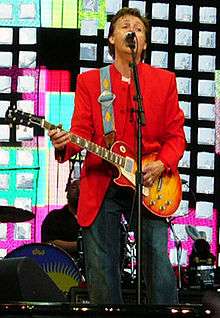
_brighten.jpg)
In 1958, new Standard model retained most specifications of the 1957 Goldtop, including PAF humbucker pickups, a maple top, and a tune-o-matic bridge with a stop tailpiece or Bigsby vibrato tailpiece. The gold color used since 1952 was replaced by a cherry-red version of the Sunburst finish long used on Gibson's flat-top and archtop acoustic and hollow electric guitars. Since the maple cap was now visible, tops were made either with a solid "plaintop" piece of maple or two bookmatched pieces of figured (curly or quilted) maple. To differentiate from the earlier Goldtop model, the new Les Paul was referred to as The Les Paul Standard. Specifications during 1958–60 varied from year to year and also from guitar to guitar. Typical 1958 Les Paul Standard necks had a thicker neck, thinner frets and lower fret height, which changed during the course of 1959 to develop into typical 1960 necks with a thinner cross-section and wider, higher frets.[note 6][note 7] The cherry dye used on the 1958–59 models faded rapidly from ultraviolet light exposure, so in early 1960 Gibson switched to a new, fade-resistant formulation which was also less translucent and slightly more orange; this is sometimes called the "tomato soup burst." Original production of the Standards lasted from 1958 to early 1961. Only about 1,700 of these early models were made and have subsequently become highly valuable.[note 7]
Production ended when, in 1961, Gibson redesigned the Les Paul to feature a "double cutaway" body, which has subsequently become the Gibson SG. Because of high demand, Gibson resumed production of Les Paul Standards in 1968.
Les Paul SG (1961–1963)
_1962.jpg)
In 1960, Gibson experienced a decline in electric guitar sales due to strong competition from Fender's comparable but much lighter double-cutaway design, the Stratocaster. In response, Gibson modified the Les Paul line. For 1961, the Les Paul was thinner and much lighter than earlier models, with two sharply pointed cutaways and a vibrato system. However, the redesign was done without Les Paul's knowledge, and he hated the design, so he asked Gibson to remove his name.[24] The single cutaway designed retained the "Les Paul" name until 1963 when Les Paul's endorsement deal with Gibson ended. Without a contract, Gibson could no longer call its guitars "Les Pauls', and it renamed them "SGs" (for "Solid Guitars).[25]
Deluxe (1968–84, 2005–present)

.jpg)
The Deluxe was among the "new" 1968 Les Pauls. This model featured "mini-humbuckers", also known as "New York" humbuckers, and did not initially prove popular. The mini-humbucker pickup fit into the pre-carved P-90 pickup cavity using an adaptor ring developed by Gibson in order to use a surplus supply of Epiphone mini-humbuckers. The Deluxe was introduced in late 1968 and helped to standardize production among Gibson's U.S.-built Les Pauls. The first incarnation of the Deluxe featured a one-piece body and slim three-piece neck. The multipiece body (a thin layer of maple on top of two layers of Honduran mahogany) arrived in 1969. In late 1969, a reinforcing neck volute was added. 1969 Deluxes feature the Gibson logo devoid of the dot over the "i" in Gibson. By late 1969/early 1970, the dot over the "i" had returned, plus a "Made In USA" stamp on the back of the headstock. The Deluxe could be specially-ordered with full-size humbucker pickups; such full size versions of the Deluxe were "Standard" spec. By 1975, the neck construction was changed from mahogany to maple, until the early 1980s, when the construction was returned to mahogany. The body changed back to solid mahogany from the pancake design in late 1976 or early 1977. Interest in this particular Les Paul model was so low that in 1985, Gibson canceled it. In 2005, the Deluxe was re-introduced.
In 1978, the Les Paul Pro Deluxe was introduced. This guitar featured P-90 pickups (like the original 1952-1956 LPs) instead of the "mini-humbuckers" of the Deluxe model, an ebony fingerboard, maple neck, mahogany body and chrome hardware. It came in ebony, cherry sunburst, tobacco sunburst or gold finish. It was discontinued in 1983.
Dark Fire
| Gibson Dark Fire | |
|---|---|
| Manufacturer | Gibson |
| Period | 2008–2010 |
| Construction | |
| Body type | Solid, Single Cut |
| Neck joint | Set-in |
| Scale | 24.75" |
| Woods | |
| Body | Mahogany, Maple Top |
| Neck | Mahogany |
| Fretboard | Ebony |
| Hardware | |
| Bridge | Tune-o-matic |
| Pickup(s) | A Burstbucker 3 humbucker at the bridge, P-90H at the neck, and a piezoelectric built into the bridge. |
| Colors available | |
| Exclusive nitrocellulose finish consisting of dark red on the Maple body top; glossy finish on body top and headstock face, satin finish everywhere else. | |
The Gibson Dark Fire, a variant of the Gibson Les Paul, was an electric solid body guitar produced by Gibson Guitar Corporation. It was a second generation Robot Guitar, using an updated version of the Powertune self-tuning system produced by Tronical Gmbh. The Dark Fire also introduced Gibson's Chameleon Tone Technology, a system consisting of onboard electronics designed to simulate various guitar tones. Additionally, the guitar included an audio interface called the Robot Interface Pack or RIP.
Pickups
The Dark Fire had one Burstbucker 3 humbucker in the bridge position, a P-90H at the neck, and a special Tronical-designed piezoelectric tune-o-matic sat in the place of the bridge. The Burstbucker 3 and P-90H were selected via the three-way selector switch. The piezoelectric could be activated via the MCK, blending the magnetic and piezoelectric together under a standard 1/4" guitar cable. Gibson supplied a TRS stereo cable that allowed the piezo signal and the magnetic signal to be split between two different amps.
Studio (1983–present)
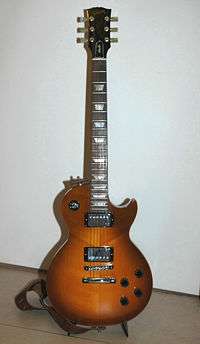
The Studio model was introduced in 1983, and is still in production. The guitar is intended for the studio musician; therefore, the design features of the "Les Paul Studio" are centered on optimal sound output and not on flashy appearance. This model retains only the elements of the Gibson Les Paul that contribute to tone and playability, including the carved maple top and standard mechanical and electronic hardware. However, the Studio design omits several stock Gibson ornamentations that do not affect sound quality, including body/neck binding. The first Studios from 1983 to 1986 were made with alder bodies rather than mahogany/maple. The current Studios come with a chambered mahogany body with either a maple or mahogany cap. The entry level Les Paul Studio "faded" has a weight relieved mahogany body and top and a satin finish.
Gibson also offered the Studio in a "standard" model. This variant was adorned with neck and body binding, ebony fretboard and sunburst paint job. All Studios at the time had dot fretboard markers and a thinner body.
Semi-acoustic model
Gibson released the ES-Les Paul in 2015. It is a semi-acoustic model with f-holes and two Alnico humbuckers. The neck is mahogany, but the sides and back are laminated maple and poplar. A mahogany block runs throughout the body to increase sustain.[26]
Les Paul's personal guitar
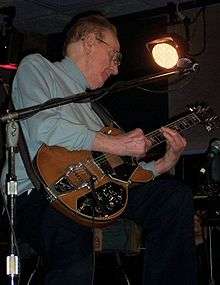
Until his death in August 2009, Les Paul himself played his personal Les Paul Guitar onstage weekly in New York City. Paul preferred his 1971 Gibson "Recording" model guitar, with different electronics and a one-piece mahogany body, and which, as an inveterate tinkerer and inventor, he had modified heavily to his liking over the years. A Bigsby-style vibrato was of late the most visible change although his guitars were formerly fitted with his "Les Paulverizer" effects.
Epiphone Les Pauls


The Gibson-owned Epiphone Company makes around 20 models of the Les Paul, most are similar copies of Gibson-made models. Made in places outside the U.S., the Epiphone Les Pauls are made from more commonly available woods using less expensive foreign labor and have less hand detailing than the Gibson models, and, as a result, sell for a lower price. Epiphone Guitar Co. has been owned by Gibson Guitars since the 1950s.[27]
Epiphone also makes several less common models of the Les Paul such as the Les Paul Goth, Les Paul Ultra/Ultra II, Les Paul Prophecy, and Les Paul Tribute Plus.[28][29]
Signature models
Jimmy Page
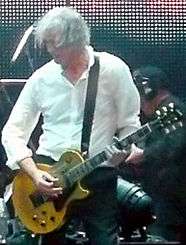
Gibson has produced three Jimmy Page signature models. The first was issued in the mid-1990s. It is based on a stock sunburst Les Paul Standard. In 2005 the Gibson Custom Shop issued a limited run of Jimmy Page Signature guitars based on Jimmy Page's 1959 "No. 1". Several years later, Gibson issued its third Jimmy Page Signature guitar, this one based on Jimmy Page's #2, issued in a production run of 325 guitars.
Slash

Slash has collaborated with Gibson on twelve signature Les Paul models—four through Gibson USA; four through the Gibson Custom Shop; and four through the Gibson subsidiary Epiphone.
The first of these guitars is the Slash "Snakepit" Les Paul Standard, which was introduced by the Gibson Custom Shop in 1996, based on the smoking snake graphic off the cover of Slash's Snakepit's debut album and a mother of pearl snake inlay covering the length of the ebony fretboard. Production was limited to 100. In 1997, Epiphone released a more affordable version of the "Snakepit" Les Paul.[30]

In 2004, the Gibson Custom Shop introduced the Slash Signature Les Paul Standard, a guitar that Gibson has used ever since as the "standard" non-limited edition Slash Les Paul.[31] In 2008, Gibson USA released the Slash Signature Les Paul Standard, an authentic replica of one of two Les Pauls Slash received from Gibson in 1988. It has an Antique Vintage Sunburst finish over a solid mahogany body with a maple top.[32] Also in 2008, the Gibson Custom Shop introduced the Slash "Inspired By" Les Paul Standard. This guitar is a replica of his 1987 Les Paul Standard.[30][33]
In 2010, Gibson released the Slash "Appetite" Les Paul Standard as a tribute to Guns N' Roses' debut album, Appetite for Destruction, which resembles the Kris Derrig built 1959 Les Paul replica Slash used for the recording of the album.[34] Production was limited to 400, with 100 aged guitars signed by Slash, and another 300 finished with the Custom Shop's VOS process.[35] Epiphone issued a more affordable version of the "Appetite" Les Paul, production of which was limited to 3,000.[36][37]
Joe Perry
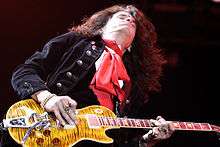
Gibson has issued two signature Les Paul guitars for Joe Perry of Aerosmith. The first was developed in 1996 and was customized with an active mid-boost control, black chrome hardware, and a translucent black finish. It was replaced in 2004 by a second, more visually distinctive Les Paul, the "Boneyard" Les Paul. This guitar is characterized by Perry's custom "Boneyard" logo on the headstock and a figured maple top with a green tiger finish, and is available with either a stopbar tailpiece or a Bigsby tailpiece. Perry has also endorsed a lower-priced replica version of the Boneyard guitar made by Epiphone.
Gary Moore

Gary Moore created his own signature Les Paul in the early 2000s, characterised by a yellow flame top, no binding and signature truss rod cover. It featured two open-topped humbucker pickups, one with "zebra coils" (one white and one black bobbin). In 2009, Gibson released another Gary Moore signature guitar, the Gibson Gary Moore BFG Les Paul. The Gary Moore BFG is much like their previous Les Paul BFG series, with the added styling of Moore's various 1950s Les Paul Standards.
Peter Frampton
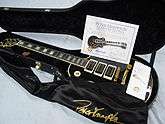
A replica of the three-pickup "Black Beauty" Les Paul Custom used by Peter Frampton as his main guitar from his days in Humble Pie through his early solo career was introduced through the Gibson Custom Shop in 2012. Frampton's original guitar was a 1954 Les Paul modified extensively. His famous guitar was presumed lost in a South American plane crash in 1980, and has only recently been found.
Michael Bloomfield
Gibson used hundreds of photographs of the late blues guitarist's instrument to produce the limited-edition Bloomfield signature. The company produced one hundred Bloomfield models with custom-aged finishes and two hundred more with the company's VOS finishing in 2009. They reproduced the tailpiece crack on the aged version, plus the mismatched volume and tone control knobs and the "Les Paul"-engraved truss rod cover on both versions, while including a toggle switch cover. The headstock was characterized by the kidney-shaped Grover tuning keys installed on the guitar before Bloomfield traded for it.
Pete Townshend

In 2005, Gibson issued three Pete Townshend signature edition Les Paul Deluxe guitars, based on Townshend's heavily customised "#1" Wine Red 1976 Les Paul Deluxe, "#3" Gold top 1976, and "#9" Cherry Sunburst 1976. These guitars were modified by Alan Rogan and used extensively on stage and in the studio with The Who. In addition to the two mini-humbuckers the guitar carried, Rogan modified Townshend's originals with a DiMarzio humbucker in the middle. Toggle switches located behind the guitar's tailpiece turned the pickup on and off and added volume boost. The control knobs were wired for volume, one for each pickup and a master volume. The reissues differed from Townshend's originals in that the reissues had an inlay at the first fret while the originals did not.
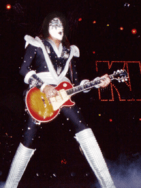
with his 3-pickup Les Paul Custom

with a Les Paul Goldtop
Ace Frehley
The Ace Frehley (KISS) signature model (released in 1997 and re-released in 2012) has three double-white DiMarzio pickups, a cherry sunburst finish (AAAA), a color image of Frehley's face in his Kiss make-up on the headstock, mother-of-pearl lightning bolt inlays, and Ace's simulated signature on the 12th fret. A Custom Shop run of only 300 guitars were built with DiMarzio PAF, Super Distortion, and Dual Sound pickups. The production run model was only built with DiMarzio Super Distortion pickups. This was one of Gibson's best selling artist runs. The more recent 2012 "Budokan" model, intended to pay tribute to the guitar used during the KISS' first trip to Japan in 1977, features mother-of-pearl block inlays (no signature at the 12th fret), Grover machine heads with pearloid banjo buttons, and a grade A maple top.[38]
Billy Gibbons
Billy Gibbons of ZZ Top has a signature model and pick-up based on his famous "Pearly Gates" 1959 Les Paul Standard.
Eric Clapton
.jpg)
Clapton played a 1960 Standard as a member of John Mayall and the Bluesbreakers as well as in the early days of Cream. The guitar was said to have been stolen while Clapton was preparing for the first Cream tour in 1966, following the recording of Fresh Cream, and was long considered an iconic instrument by Clapton's fans. Gibson announced production of the Clapton 1960 Standard, also nicknamed the "Beano Burst", in 2010. Gibson says the instrument "accurately represents what Eric Clapton personally feels his 1960 Les Paul should be", with Clapton consulting on the design of the guitar. Production is limited but all feature period-correct hardware, two Gibson reproduction PAF humbucking pickups, and subtly figured "antiquity burst" maple tops.
Paul Kossoff
Paul Kossoff, of Free and Back Street Crawler, favored a 1959 Les Paul Standard. In 2011–12, Gibson's Custom Shop made a reproduction of Kossoff's Standard, featuring a so-called "green-lemon" flametop, two-piece carved maple top, mahogany body and neck, Custom Bucker humbucking pickups and kidney-bean shaped Grover tuners similar to those Kossoff had installed on the instrument. 100 Kossoff models were made to resemble the guitar at the time of Kossoff's death in 1976, with another 250 in a VOS finish.
Alex Lifeson
Gibson introduced an Alex Lifeson R40 Les Paul Axcess signature guitar in June 2015. This is a limited edition with 50 guitars signed and played by Lifeson, and another 250 available without the signature.
Brian May
Besides using his Red Special, Brian May used a Gibson Les Paul and the Fender Stratocaster on the Sheer Heart Attack tour for 8 months.
Les Paul players
Les Paul copies and lawsuits
Although early Les Paul imitations in the 1960s and 1970s, such as those made by Höfner, Hagström, Harmony Company, and Greco differed from Gibson's designs,with different electronics and even bolt-on necks, in the late 1970s some Japanese companies came very close to perfecting copies of the original 1958–60 Standards. A lawsuit was brought by the Norlin Corporation (the parent company of Gibson guitars) in 1977, and was based on an Ibanez headstock design that had been discontinued by 1976. These guitars later became known as "lawsuit" guitars.
ESP Guitars makes several guitars based on the Les Paul design. The Edwards and Navigator lines are made in Japan in the vein of the late 1970s and 1980s "lawsuit" model guitars from Tokai, Burny, and Greco, complete with Gibson style headstocks.
Heritage Guitars, founded in 1985 by four long-time Gibson employees when Gibson relocated to Nashville, continues to build guitars at the original factory in Kalamazoo, Michigan. Many of their models are inspired by Gibson's late-1950s/early-1960s sunbursts and Customs.
In 2006, Gibson lost a lawsuit against PRS Guitars,[39] Gibson claiming PRS was infringing on the Les Paul shape and design. The court's decision allowed PRS to reintroduce single cutaway versions of its instruments.
In 2008, Gibson lost the trademark for the Les Paul in Finland. According to the court, "Les Paul" has become a common noun for guitars of a certain type. The lawsuit began when Gibson sued Musamaailma, which produces Tokai guitars, for trademark violation. However, several witnesses testified that the term "Les Paul" denotes character in a guitar rather than a particular guitar model. The court also found it aggravating that Gibson had used Les Paul in the plural form and that the importer of Gibson guitars had used Les Paul as a common noun. The court decision will become effective, as Gibson is not going to appeal.[40]
References
- ↑ Ian Courtney Bishop (March 1990). The Gibson Guitar from 1950 (2nd ed.). Bold Strummer. pp. 3. ISBN 978-0-933224-46-9.
- ↑ Jim Henke. "In the Museum: The Les Paul Guitar (Video)". Education – Inside the Classroom. The Rock and Roll Hall of Fame and Museum.
- ↑ "Les Paul Electric Guitar "Clunker" – Modified 1942 Epiphone Broadway". The Rock and Roll Hall of Fame and Museum.
- ↑ "1942 Epiphone Broadway". archtop.com.
- ↑ Les Paul, Michael Cochran (2005). Les Paul – In His Own Words. Russ Cochran. pp. 240, ?.
- ↑ Les Paul (1988). Little Black Box (video).(a triggering device for live performance effects)
- 1 2 Wheeler, Tom (1992). American Guitars. Harper. p. 140. ISBN 0-06-273154-8.
- ↑ Freeth, Nick; Charles Alexander (2004). Ray Bonds, ed. The Illustrated Directory of Guitars. Barnes & Noble, Inc. pp. 290–293. ISBN 0-7607-6317-8.
- ↑ .Lawrence, Robb (2008). The Early Years of the Les Paul Legacy: 1915–1963. Hal Leonard Corp. p. 304. ISBN 978-0634048616.
- 1 2 Duchossoir, Andre (1998). Gibson Electrics: The Classic Years. Hal Leonard. pp. 42–44. ISBN 0-7935-9210-0.
- ↑ Burrluck, Dave (September 2007). "'The Keithburst Les Paul'". Guitarist Magazine: 55–58.
- ↑ Bacon, Tony. (2002). "50 Years of the Gibson Les Paul: Half a Century of the Greatest Electric Guitars". Hal Leonard Corporation. pp. 39. Retrieved 16 January 2015.
- ↑ Bacon, Tony (2000). Electric Guitars:The Illustrated Encyclopedia. Thunder Bay Press. p. 123. ISBN 978-1-59223-053-2.
- ↑ Bacon, Tony (2002). 50 Years of the Gibson Les Paul. Backbeat Books. pp. 38, 50. ISBN 0-87930-711-0.
- ↑ Moseley, Willie G. (February 2012). "The Gibson Les Paul Triumph". Vintage Guitar. p. 60.
- ↑ Pittman, Aspen (2003). The Tube Amp Book. Hal Leonard. pp. 66, 69–70. ISBN 978-0-87930-767-7.
- ↑ Maloof, Rich (2004). Jim Marshall, father of loud: the story of the man behind the worlds most famous guitar amplifiers. Hal Leonard. pp. 48–49. ISBN 978-0-87930-803-2.
- ↑ http://dozin.com/jers/guitar/history.htm
- ↑ White, Forrest (1994). Fender: The Inside Story. Backbeat Books. pp. 180–181.
- ↑ Bonds, Ray, ed. (2006). The Illustrated Directory of Guitars. Barnes & Noble/Salamander Books. p. 376.
- ↑ Dirks, Rebecca; Egolf, James. "A Modern History of the Gibson Custom Shop". Premier Guitar. Retrieved 5 December 2014.
- ↑ Les Paul Custom Classic, Gibson.com
- ↑ Duchossoir, A. R. (1998). "Les Paul Special & SG Special". Gibson Electrics: The Classic Years: An Illustrated History of the Electric Guitars Produced by Gibson Up to the Mid-1960s. Musical Instruments Series (revised ed.). Hal Leonard Corporation. p. 210. ISBN 978-0-79359210-4.
- ↑ Burrows, Terry (2013). 1001 Guitars To Dream of Playing Before Die. Universe. p. 262. ISBN 978-0-7893-2701-7.
- ↑ Freeth, Nick. The Complete Guitar Encyclopedia=2012. Parragon. p. 56. ISBN 978-1-4454-9313-8.
- ↑ Prown, Pete (June 2015). "F-Hole with Soul: ES-Les Paul". Vintage Guitar. p. 124.
- ↑ "Epiphone: A History". Epiphone.com. Retrieved 24 February 2012.
- ↑ "Epiphone Goth Les Paul Studio". Epiphone.com. Retrieved February 23, 2012.
- ↑ "Epiphone Ultra II". Epiphone.com. Retrieved February 23, 2012.
- 1 2 Drozdowski, Ted (2008-04-08). "From 1988 to 2008, Slash's Les Pauls Through the Years". Gibson.com. Retrieved 2011-04-30.
- ↑ "Slash Signature Les Paul on SlashParadise". www.slashparadise.com. November 10, 2012.
- ↑ "Gibson USA Slash Signature Les Paul Standard". Gibson.com. Retrieved April 30, 2011.
- ↑ "Gibson Custom "Inspired By" Slash Les Paul Standard". Gibson.com. Retrieved April 30, 2011.
- ↑ "Gibson USA Slash "Appetite" Les Paul Standard". Gibson.com. Retrieved April 30, 2011.
- ↑ "The Guitar That Saved Rock N' Roll". Gibson.com. 2010. Retrieved July 25, 2011.
- ↑ "Epiphone Slash "Appetite" Les Paul Standard". Gibson.com. Retrieved April 30, 2011.
- ↑ "Epiphone Slash Appetite Les Paul Standard". Epiphone.com. Retrieved 23 February 2012.
- ↑ "Ace Frehley "Budokan" Les Paul Custom". Gibson Guitar Co.
- ↑ Rob Power (June 8, 2006). "Gibson lawsuit ends with PRS victory". MI Pro. UK: Intent Media.
- ↑ Tuomo Pietiläinen (Sep 5, 2008). "Käräjäoikeus tuomitsi Gibsonin Les Paul -kitaran yleisnimeksi" [The district court ruled Gibson Les Paul guitar to be generic]. Helsingin Sanomat (in Finnish).
Notes
- ↑ Original "The Log" was exhibited at Country Music Hall of Fame, Nashville. A replica of "The Log" (loaned from Les Paul Foundation) have been exhibited on "Les Paul Experience" permanent exhibition at Waukesha Couty Museum.
- ↑ This Les Paul prototype was refinished in cherry sunburst from original goldtop, pickups are replaced with his lo-impedance type, and also Bigsby vibrato tailpiece is installed. This guitar have been exhibited on "Les Paul Experience" permanent exhibition at Waukesha Couty Museum.
- ↑ This Les Paul prototype (white) has an appearance similar to the later Les Paul Personal model because its pickups were replaced by the low-impedance type, however, the existence of trapezoid-type bridge/tailpiece imply that it is early Les Paul.
- ↑ In the summer of 1952, Gibson Les Paul Goldtop was priced at US$209.
- ↑ This guitar (1953 Goldtop exhibited at FUZZ Guitar Show 2008) was used by Carl Perkins on many of his early "Sun Records" Recordings
- ↑ "10 Most Valuable Guitars", Vintage Guitar (2010), mentioned on:Paul Schille (Dec 17, 2010), Vintage Guitar Releases List of 10 Most Valuable Guitars, TheGiggingMusician.com
- 1 2 Greenwood, Alan; Gil Hembree (April 2011). "25 Most Valuable Guitars". Vintage Guitar. pp. 38–40.
The 1958–60 Standard is one of the highest priced vintage guitar models on the market, ranked at # on the 2011 Top 25 published by Vintage Guitar, and worth between $225,000 and $375,000.
Further reading
- Electric Guitar Man: The Genius of Les Paul (Library Binding). Edwin Brit Wyckoff. Enslow Elementary (April 2008). ISBN 978-0-7660-2847-0
- 50 Years of the Gibson Les Paul: Half a Century of the Greatest Electric Guitars (Paperback). Tony Bacon. Backbeat Books 1st edition (April 26, 2002). ISBN 0-87930-711-0
- Million Dollar Les Paul: In Search of the Most Valuable Guitar in the World (Paperback). Tony Bacon. Jawbone Press 1st edition (2008). ISBN 978-1-906002-14-5
- "Review: A riff on robotics with self-tuning guitar". U-T San Diego. Retrieved 23 April 2015. – Gibson Dark Fire
- "Bob Marley The Father of Music". p. 148. – Gibson Dark Fire
- Wilson Rothman. "Gibson's Dark Fire: Les Paul Reborn as RoboCop". Gizmodo. Gawker Media. Retrieved 23 April 2015.
External links
| Wikimedia Commons has media related to Gibson Les Paul. |
| Wikimedia Commons has media related to Lester William Polfuss. |
- Official website
- Gibson Les Paul Statue of Liberty Guitar
- Gibson Dark Fire site
- All About Gibson Les Paul Guitars
.jpg)
